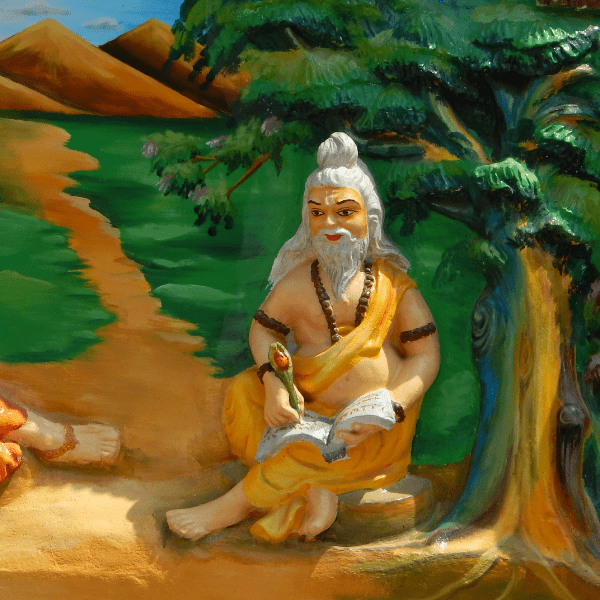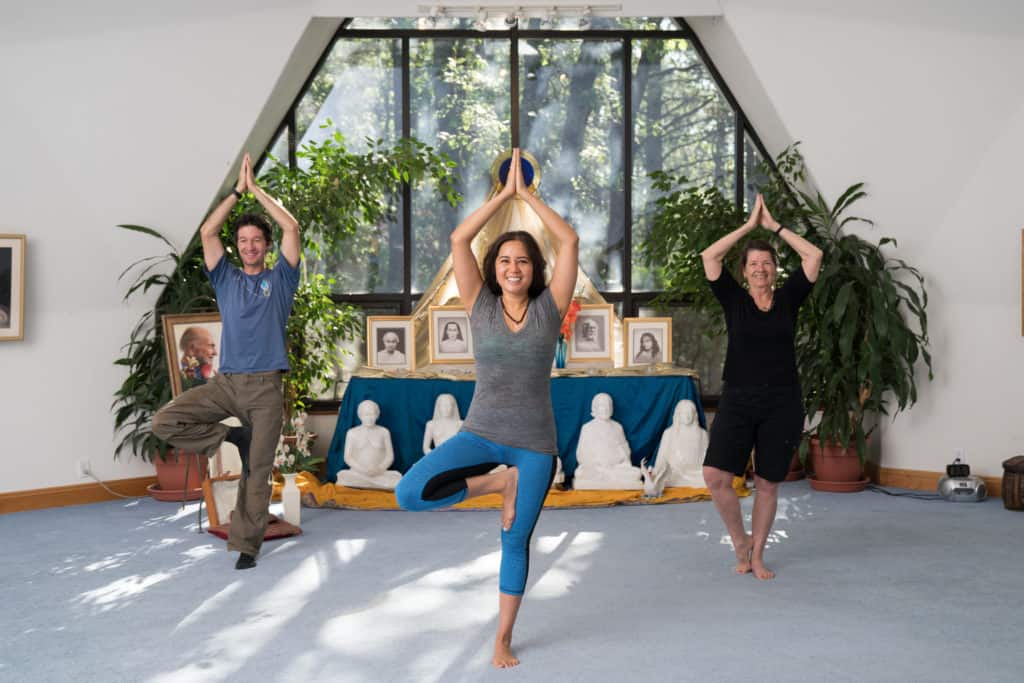To Those Who Are Considering Living A Yogic Lifestyle
In this post, other than learning about key components of the yogic lifestyle, you’ll find some ‘Bonus‘ videos to help you deepen your understanding.
You can select any component to begin reading with, but, if you begin with Philosophy first, it will help you connect well with other components.
Let’s begin!
Philosophy

Yoga is quite possibly the most ancient science known to man.
Yoga, literally, means “union.” This union can be understood on different levels: philosophically, as that of the relative, limited self with the absolute Self; religiously, as that of the individual soul with the Infinite Spirit; psychologically, as the integration of the personality – a state wherein a person no longer lives at cross-purposes with himself; emotionally, as the stilling of the waves of likes and dislikes, permitting one to remain in all circumstances complete in himself.
It is this last level that serves as the classical definition of yoga by the ancient sage Patanjali.
Patanjali’s profound Yoga Sutras, or aphorisms, have been looked upon for millennia as yoga’s definitive scripture. He wrote: “Yogas chitta vritti nirodh” – ”Yoga is the neutralization of the waves of feeling.” Chitta (feeling) has been variously translated as “mind-stuff,” “consciousness,” “subconsciousness,” “the lower mind.”
The purpose of yoga, similarly, is to open the windows of the mind, and to awaken every cell of the body and brain to reflect and magnify the energy that comes to it from the surrounding universe. (A comparison might be drawn to modern transistor radios which, because of their efficiency, can pick up programs where, a few years ago, nothing so small would have been able to get a sound.)
As you pursue your yoga practices, remember that your aim must be to become spiritually completely open, to receive. Never hurry. Never strain. Feel that what you do is, in a sense, being done through you, by your willing cooperation with divine forces.
For India’s ancient seers understood, as modern man so far has not, that man lives as much by his philosophy of life as by his practical knowledge. Everything he does expresses, in a sense, this philosophy. The very way he moves his body reveals to the sensitive eye whether he sees life as a series of contests with threatening but nameless foes, or as a perpetual shopping expedition for familiar ideational antiques, or as a brave and joyous adventure into the shining unknown.
The Man simply cannot think and have no philosophy at all.
Yoga Asanas
Bonus: With Introduction to Ananda Yoga Video

Hatha yoga, the yoga of physical postures, is not a separate yoga science in its own right; rather it is the physical discipline of the integral teaching known as raja yoga.
The yoga postures help to harmonize the body with natural law.
The yogi is shown how to develop his own latent powers rather than lean weakly on some outer agent for his physical well-being. Inasmuch as ill health is the unnatural, not the natural, condition of the body, primary emphasis in hatha yoga is placed on freeing the body of any impurity that may prevent it from functioning as it should, rather than on introducing outside forces strong enough to destroy all disease.
A piano placed without rollers on sandpaper would be difficult even for the strongest man to move. But if the piano were placed on well-oiled rollers and on a slick floor, even a child might be able to push it with ease. Even a little physical vitality can become dynamic, if the unnatural obstructions to its flow are removed.
Hatha yoga also exercises a gentle massage on the internal organs and glands, gradually strengthening them to the point where providing outside aid for them would only be “carrying coals to Newcastle.”
Much emphasis is given in yoga to the elimination of waste from the body. One form of waste, not commonly thought of as such, is tension. Tension blocks the natural flow of energy in the body. It paralyzes one’s normal sense of physical and mental harmony.
Human ills all derive more or less directly from impairments in the body’s energy-flow. The main reason for eliminating waste from the body is to permit the free flow of energy. Tension, the chief obstruction to this flow, is the first obstacle to be overcome if the body is to return to its divinely natural state.
Important Guidelines
- Always do the postures when you are calm, physically and emotionally.
- They should be done if possible in the open air, or near to an open window. It’s best not to practice them in a closed room, or where the air is stale.
- Don’t be in a hurry to go through the poses. Hold each pose after you get into it; remember that the benefits often begin only after you have remained in a pose for a while.
- Rest after each position for about as long as you held it, or for as long as it takes for your heart to return to its normal beat.
- Try to do the postures at the same time every day. Regularity is an important feature of yogic discipline. As my great guru said: “Routinize your life. God created routine. The sun shines until dusk, and the stars shine until dawn.”
- Approach the postures with an attitude of peace.
Breathing
Bonus: With Basic Breathing Techniques Video

The Hindu word for “breath,” “life,” and “energy” is the same: prana.
Prana surrounds us in the air we breathe. We shall learn in a later lesson how to draw on this prana by other means than the breath.
The breath is, however, one very important means. We draw not only air into our body when we breathe, but also vitality, strength, courage.
When we exhale, we throw out of our system not only carbon dioxide, but also mental and emotional impurities: discouragement, weakness, despair. But inasmuch as these are mental and emotional tendencies, we must use mental “lungs” to draw them into us or to expel them, even as we must use our physical lungs to inhale and exhale air.
When a deliberate mental effort is made to absorb prana from the air that we breathe, then breathing can give us psycho-spiritual benefits as well.
The movements of prana are not only those by which it enters the body through the breath. There are movements of prana also within one’s own body. These, too, reflect themselves in the breath.
When we are emotionally disturbed, the flow of energy in the body is similarly disturbed, and the effect on the breath is instantaneous: The breathing becomes erratic, jerky, rapid.
An intimate connection exists between the mind and the breath. This interesting truth can be turned to good advantage, for as the mind influences the breath, so also the breath influences the mind.
Harmful emotional states can be overcome to a large extent by deliberate, deep, harmonious breathing.
As a general principle (there are exceptions in some of the yogic breathing exercises), one should always inhale through the nostrils. The reasons for this principle are subtle as well as obvious.
The obvious ones are that breathing through the nostrils filters out dust and impurities that otherwise would enter the lungs, and warms the air before it reaches the delicate inner membranes.
The subtle reasons are many, and will be gone into in the course of these lessons. One is that the air coming up through the nostrils cools the brain and clarifies one’s thinking.
People who breathe habitually through the mouth tend to be somewhat dull-minded. Try sometimes, when you inhale, to feel the air coming up into your brain, refreshing and cooling it.
Meditation

Meditation is to religion what the laboratory is to physics or chemistry.
Whether one follows the outward forms of religion depends more or less on personal taste, but whether one seeks in his life some of religion’s practical, inner benefits is a matter of life or living death.
The true purpose of religion is to point out that human existence on every level is empty when only emptiness is affirmed, and when inner awareness is allowed to become nothing more than an echo of the world, offering nothing creatively to the world in return.
Some people confine their understanding of religion to a reproving frown, or to some pious (and usually fleeting) emotion. They see not that religion is one of the very sinews of a healthy, normal existence. Without ever going to church or reciting a single creed, one can be religious in the true sense of the word.
Simple, genuine good will for one’s neighbors is a religious phenomenon. So also is an experience of wonder at the mystery of the vast universe.
The central teachings of religion are universal truths of life itself. To reject those teachings is to reject life.
Outward religious practices, of course, without the development of an inner life, are of secondary value. In their practical effects they are rather like trying to fly an airplane with an insufficient wingspread: No matter how much of a “racing start” one gets with them, he can’t quite get up off the ground. Essential to the religious life is an inner unfoldment. Vital to this unfoldment is the daily practice of meditation.
What is meditation?
It is not, as so many people assume it to be, a process of “thinking things over.” Rather, it is making the mind completely receptive to reality. It is stilling the thought processes – those restless ripples that bob on the surface of the mind – so that truth, like the moon, maybe clearly reflected there. It is listening to God, to Universal Reality, for a change, instead of doing all the talking and “computing” oneself.
This is how all the great discoveries have been made – not by human creation, but by receptivity to rays of inspiration from higher sources than those with which the conscious mind is familiar.
Try meditating every day for at least fifteen minutes (half an hour would be even better). Usually, the best time for meditation will be directly after your practice of yoga postures.
Diet

To return one’s body to a natural state, it is necessary to eat natural foods. In our modern age, emphasis in diet, as in medicine, is on the unnatural, on the man-made. The result of wrong diet, as of other forms of wrong living, is disease.
Let us consider an interesting emphasis of the yoga teachings, one that is related not only to natural diet, but also to the principle of relaxation – so vital to self-integration that we have just considered in the foregoing section.
Yogis emphasize the importance of food that is cooling to the system. Harmful food, they say, heats the system by introducing impurities into it that block the normal flow of prana in the body. Resistance to an electrical current will heat the wire through which the electricity passes. The same thing happens with resistance to the flow of prana through the nervous system. Heat is only a symptom of a system that is not working as freely and harmoniously as it should. The principle is similar to that of heat that is produced by friction. It is no accident that when we tell someone to relax, we may say, “Keep cool.” When a person is upset, on the other hand, we may describe him as “hot and bothered.” Emotions have a heating or a cooling effect on the entire nervous system; so also do foods.
Excessively spiced foods, alcoholic beverages, too many carbohydrates, artificial stimulants, and stale or devitalized foods are unnatural to the body and are said to have a heating effect on it. Overcooked foods have a similar effect. Fresh fruits, nuts, raw or lightly cooked vegetables, milk or fresh milk products, and also whole grains are said to be cooling to the nervous system. Anything that excites the body is heating to it; anything that relaxes it is cooling.
In yoga teachings, much emphasis is placed on a harmonious, rather than a stimulating, diet. If the inner Self is allowed to work through a relaxed and peaceful nervous system, it will be able to fill the body with energy and strength. External stimuli prevent this harmonious expression from within. Dietary stimulants are therefore self-defeating.
Stimulants, according to yoga teachings, fall into the category of rajasic, or activating, foods, as opposed to foods that completely enervate (tamasic foods), or to those which spiritualize man’s consciousness (sattwic foods). Rajasic foods would include meat, eggs, garlic, and onions. Onions and garlic have some medicinal properties, but – from a standpoint of yoga practice – they tend to excite the nervous system and are usually excluded from the yogi’s diet. I do not know what to say here in the West, where the demands of our environment are themselves so rajasic. Yoganandaji fed us onions and garlic in America, as well as eggs. I assume that his reason for doing so was that the Western world demands a certain adaptation of the Eastern teachings. Here, perhaps, some rajasic food is desirable, if only to help us to keep abreast of the currents of consciousness swirling around us.
Nonetheless, one should endeavor on the yogic path to introduce into his diet foods that are rather wholesome than stimulating.
Source – Compiled excerpts from the book “The Art and Science of Raja Yoga” by Swami Kriyananda.



